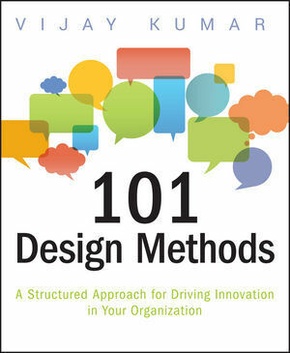101 Design Methods - A Structured Approach for Driving Innovation in Your Organization
| Verlag | Wiley & Sons |
| Auflage | 2012 |
| Seiten | 336 |
| Format | 19,2 x 23,1 x 1,5 cm |
| Gewicht | 668 g |
| Artikeltyp | Englisches Buch |
| ISBN-10 | 1118083466 |
| EAN | 9781118083468 |
| Bestell-Nr | 11808346UA |
The first step-by-step guidebook for successful innovation planning
Unlike other books on the subject, 101 Design Methods approaches the practice of creating new products, services, and customer experiences as a science, rather than an art, providing a practical set of collaborative tools and methods for planning and defining successful new offerings. Strategists, managers, designers, and researchers who undertake the challenge of innovation, despite a lack of established procedures and a high risk of failure, will find this an invaluable resource. Novices can learn from it; managers can plan with it; and practitioners of innovation can improve the quality of their work by referring to it.
Inhaltsverzeichnis:
FOREWORD by JAMES P. HACKETT vii
ACKNOWLEDGMENTS ix
INTRODUCTION 1
Four Core Principles of Successful Innovation 3
Principle 1: Build Innovations Around Experiences 3
Principle 2: Think of Innovations as Systems 5
Principle 3: Cultivate an Innovation Culture 6
Principle 4: Adopt a Disciplined Innovation Process 7
A Model of the Design Innovation Process 8
The Design Innovation Process 8
Process Is Nonlinear 9
Process Is Iterative 9
Seven Modes of the Design Innovation Process 10
Mode 1: Sense Intent 10
Mode 2: Know Context 10
Mode 3: Know People 11
Mode 4: Frame Insights 11
Mode 5: Explore Concepts 12
Mode 6: Frame Solutions 12
Mode 7: Realize Offerings 13
Understanding Methods 13
Mode 1: SENSE INTENT 15
Sense Intent: Mindsets 16
Sensing Changing Conditions 17
Seeing Overviews 17
Fore seeing Trends 18
Reframing Problems 18
Forming an Intent 19
Sense Intent: Methods 21
1.1 Buzz Reports 22
1.2 Popular Media Scan 24
1.3 Key Facts 26
1.4 Innovation Sourcebook 28
1.5 Trends Expert Interview 30
1.6 Keyword Bibliometrics 32
1.7 Ten Types of Innovation Framework 34
1.8 Innovation Landscape 36
1.9 Trends Matrix 38
1.10 Convergence Map 40
1.11 From...To Exploration 42
1.12 Initial Opportunity Map 44
1.13 Offering-Activity-Culture Map 46
1.14 Intent Statement 48
Mode 2: KNOW CONTEXT 51
Know Context: Mindsets 52
Knowing Context History 53
Understanding Frontiers 54
Seeing System Overviews 55
Understanding Stakeholders 56
Using Mental Models 57
Know Context: Methods 59
2.1 Contextual Research Plan 60
2.2 Popular Media Search 62
2.3 Publications Research 64
2.4 Eras Map 66
2.5 Innovation Evolution Map 68
2.6 Financial Profile 70
2.7 Analogous Models 72
2.8 Competitors-Complementors Map 74
2.9 Ten Types of Innovation Diagnostics 76
2.10 Industry Diagnostics 78
2.11 SWOT Analysis 80
2.12 Subject Matter Experts Interview 82
2.13 Interest Groups Discussion 84
Mode 3: KNOW PEOPLE 87
Know People: Mindsets 88
Observing Everything 89
Building Empathy 90
Immersing in Daily Life 91
Listening Openly 92
Looking for Problems and Needs 93
Know People: Methods 95
3.1 Research Participant Map 96
3.2 Research Planning Survey 98
3.3 User Research Plan 100
3.4 Five Human Factors 102
3.5 POEMS 104
3.6 Field Visit 106
3.7 Video Ethnography 108
3.8 Ethnographic Interview 110
3.9 User Pictures Interview 112
3.10 Cultural Artifacts 11 4
3.11 Image Sorting 116
3.12 Experience Simulation 120
3.13 Field Activity 122
3.14 Remote Research 124
3.15 User Observations Database 126
Mode 4: FRAME INSIGHTS 129
Frame Insights: Mindsets 130
Exploring Systems 131
Looking for Patterns 132
Constructing Overviews 133
Identifying Opportunities 134
Developing Guiding Principles 135
Frame Insights: Methods 137
4.1 Observations to Insights 138
4.2 Insights Sortin

